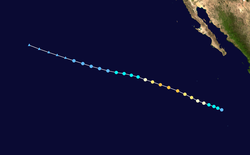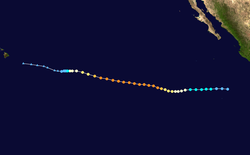2006 Pacific hurricane season
Period of formation of tropical cyclones in the Eastern Pacific Ocean in 2006 From Wikipedia, the free encyclopedia
Remove ads
The 2006 Pacific hurricane season was an above normal hurricane season with 19 named storms of 11 which were hurricanes and 6 were major hurricanes it was the most active season since 2000 Pacific hurricane season It officially began May 15, 2006 in the eastern Pacific, designated as the area east of 140°W, and began on June 1 2006 in the central Pacific, which is between the International Date Line and 140°W. Both seasons officially ended on November 30, 2006. These dates conventionally delimit the period of each year when most tropical cyclones form in the eastern Pacific basin.
Remove ads
Storms
Tropical Storm Aletta
On May 27 Tropical Depression One-E formed. It became Tropical Storm Aletta later on. Aletta stalled offshore Mexico causing minor damage. Tropical Storm Aletta weakened to a tropical depression and died on May 30.[1]
Tropical Depression Two-E
Two-E formed off shore Mexico on June 3. It died 2 days later. Two-E produced 15 inches of rain in Mexico before it died.[2]
Major Hurricane Bud
Bud was a Category 3 storm. It rapidly strengthened and then weakened just as fast.
Hurricane Carlota
Carlota caused light rain in Mexico but no damage was reported. It was a Category 1 storm.
Major Hurricane Daniel
Not to be confused with Storm Daniel or Hurricane Danielle

Daniel was a long lived Major hurricane that Affected Hawaii with some rain. It peaked as a Category 4. It was the second strongest storm this year.
Tropical Storm Emilia
It caused some rain in Mexico, causing minor damage.
Tropical Storm Fabio
Fabio caused heavy rainfall in Hawaii.
Tropical Storm Gilma
Gilma produced light rain in Mexico. It was also the weakest storm so far.
Hurricane Hector
Hector was a Category 2 hurricane. It made it to the Central Pacific.
Major Hurricane Ioke
Ioke was the strongest hurricane ever in the Central Pacific that threated the Johnson Atoll and Wake Island. It formed on august 20. Ioke rapidly became a major hurricane 36 hours later. Ioke went extratropical on September 6. Damage was nearly $100 million. Ioke was retired at the end of the year. It also caused heavy rain in Alaska. Ioke is the most intense storm ever in the central Pacific and the only Category 5 storm that formed in the basin.
Major Hurricane Illena
Illena killed one person in Mexico. It peaked as a Cateogory 3 storm.
Major Hurricane John
John started as Tropical Depression Eleven-E and later on became a tropical storm and then a hurricane. The hurricane peaked as a Category 4. John killed 5 when it hit Baja California as a Category 2 storm on September 1. Hurricane John died on September 4.[3]
Hurricane Kristy
Kristy was a Category 1 hurricane that was outflowed by Hurricane John.
Major Hurricane Lane
Lane caused severe damage in Mexico, when it hit there as a Category 3 major hurricane. Lane killed 4 people and left $203 million in damage.
Tropical Storm Miriam
Tropical Depression Two-C
Tropical Depression Three-C
Three-C was a short lived tropical depression that started several hundred miles southwest of Hawaii. It died the next day while no where near any land.[4]
Tropical Storm Norman
Norman struck Mexico as a tropical depression, causing minor damage.
Tropical Storm Olivia
Olivia did not affect land.
Tropical Depression Four-C
Four-C was a short lived tropical depression. It formed on October 13 and died the next day. The remaims of Four-C caused heavy rain in Hawaii.
Hurricane Paul
Paul was a Cateogory 2 hurricane that killed 4 in Mexico.
Tropical Depression Eighteen-E
Tropical Storm Rosa
Rosa produced light rain to Mexico in November.
Tropical Depression Twenty-E
Tropical Depression Twenty-E formed and died on the same day, November 11. Twenty-E did not affect any land.[5]
Hurricane Sergio
Sergio was also a Cateogory 2 storm. It was also the strongest November storm.
Other Systems
Tropical Storm 91C
On October 28, 2006, a cut-off extratropical cyclone stalled over the northeast Pacific Ocean and began to strengthen. By October 31, the storm had acquired tropical characteristics, including an eye, convection, and a warmer-than-average core.The system reached peak intensity on November 1, before slowly weakening and looping towards the Pacific Northwest. The system made landfall in Washington state on November 3, before rapidly weakening and dissipating on the next day. During the duration of the storm, the system was known as Storm 91C. The storm's true nature still remains controversial among meteorologists today, due to disputes over the storm's exact structure and whether or not it had obtained tropical or subtropical characteristics. Because the storm was not within the area of responsibility of the National Hurricane Center or the Central Pacific Hurricane Center, it was never assigned a name.
Remove ads
Storm names
The following names were used for named storms that formed in the northeast Pacific in 2006.[6] This is the same list that was used in the 2000 season. There were no names retired from the northeast Pacific list. Therefore, the same list was reused in the 2012 season.
|
|
For storms that form in the Central Pacific Hurricane Center's area of responsibility, encompassing the area between 140 degrees west and the International Date Line, all names are used in a series of four rotating lists. The next four names that were slated for use in 2006 are shown below, however only the name Ioke was used.
|
|
|
Retirement
The name Ipot was retired from the north-central Pacific list by the PAGASA in the spring of 2007 and replaced with Indang.[7] During the 61st Interdepartmental Hurricane Conference, the Philippines State Civil Defense requested the retirement of the name Dumudura, citing that the storm had become memorable due to threat of damage.[8] However, the request was denied, as the name remains on the tropical cyclone naming list.[6]
Remove ads
Season effects
This is a table of all the storms that formed in the 2006 Pacific hurricane season. It includes their duration, names, landfall(s), denoted in parentheses, damages, and death totals. Deaths in parentheses are additional and indirect (an example of an indirect death would be a traffic accident), but were still related to that storm. Damage and deaths include totals while the storm was extratropical, a wave, or a low, and all the damage figures are in 2006 USD.
| Saffir–Simpson Hurricane Scale | ||||||
| TD | TS | C1 | C2 | C3 | C4 | C5 |
Remove ads
Related pages
Notes
- Though Hurricane Ioke did not make landfall, its strike on Wake Island is included in the table, due to the severe damage on the island.
- In its report on Tropical Storm Norman, the National Hurricane Center did not specify whether the storm moved ashore or not. However, in its report to the World Meteorological Organization, officials from Mexico included Norman in the storms that moved ashore along the country.
Remove ads
References
Other websites
Wikiwand - on
Seamless Wikipedia browsing. On steroids.
Remove ads





















































